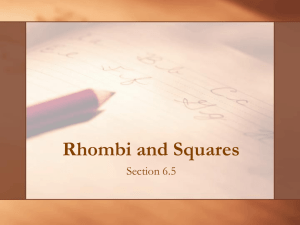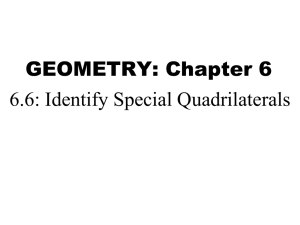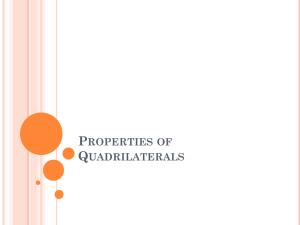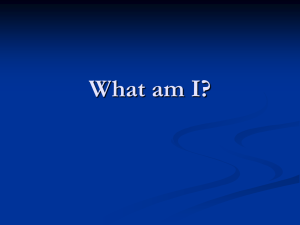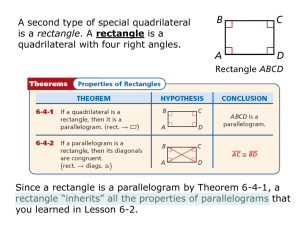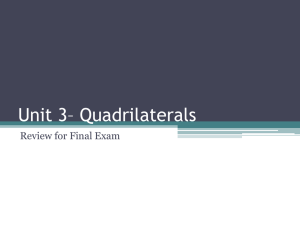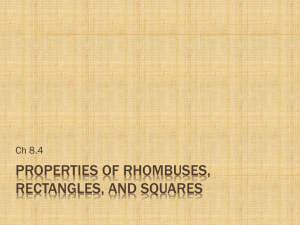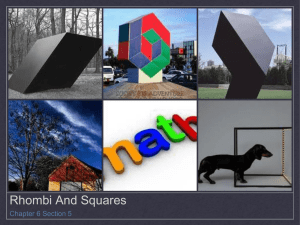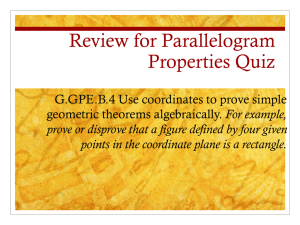Properties of Rhombuses, Rectangles, & Squares
advertisement
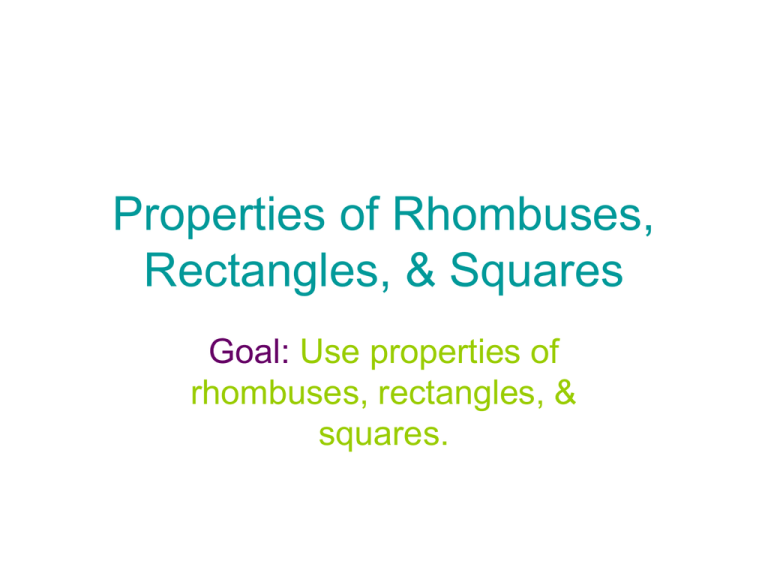
Properties of Rhombuses, Rectangles, & Squares Goal: Use properties of rhombuses, rectangles, & squares. Vocabulary Rhombus A rhombus is a parallelogram with four congruent sides. Rectangle A rectangle is a parallelogram with four right angles. Square A square is a parallelogram with four congruent sides and four right angles. (A square is both a rhombus and a rectangle any property of these is also in the square.) Rhombus Corollary A quadrilateral is a rhombus iff (if and only if) it has four congruent sides. ABCD is a rhombus iff AB BC CD AD. Rectangle Corollary A quadrilateral is a rectangle iff (if and only if) it has four right angles. ABCD is a rectangle iff A, B, C , and D are right angles. Square Corollary A quadrilateral is a square iff (if and only if) it is a rhombus and a rectangle. ABCD is a square iff AB BC CD AD and A, B, C, and D are right angles. Example 1 Use properties of special quadrilaterals For any rhombus RSTV, decide whether the statement is always or sometimes true. Draw a sketch and explain your reasoning. a. S V Solution: By definition, a rhombus is a parallelogram with four congruent sides. By Theorem 8.4, opposite angles of a parallelogram are congruent. S V. The statement is always true. Example 1 (cont) b. If rhombus RSTV is a square, then all four angles are congruent right angles. T V if RSTV is a square. Because not all rhombuses are also squares, the statement is sometimes true. Example 2 Classify special quadrilaterals Classify the special quadrilateral. Explain your reasoning. The quadrilateral has four congruent sides. One of the angles is not a right angle, so the rhombus is not also a square. By the Rhombus Corollary, the Quadrilateral is a rhombus. Checkpoint 1 For any square CDEF, is it always or sometimes true that CD DE ? Explain your reasoning. Always; a square has four congruent sides. Checkpoint 2 A quadrilateral has four congruent sides and four congruent angles. Classify the quadrilateral. square Theorem 6.11 A parallelogram is a rhombus if and only if its diagonals are perpendicular. Parallelogram ABCD is a rhombus iff AC BD. Theorem 6.12 A parallelogram is a rhombus if and only if each diagonal bisects a pair of opposite angles. Parallelog ram ABCD is a rhombus iff AC bisects BCD and BAD and BD bisects ABC and ADC. Theorem 6.13 A parallelogram is a rectangle if and only if its diagonals are congruent. Parallelogram ABCD is a rectangle iff AC BD. Example 3 List properties of special parallelograms Sketch rhombus FGHJ. List everything you know about it. Solution By definition, you need to draw a figure with the following properties: The figure is a parallelogram. The figure has four congruent sides. Because FGHJ is a parallelogram, it has these properties: Opposite sides are parallel and congruent. Opposite angles are congruent. Consecutive angles are supplementary. Diagonals bisect each other. (Continued next slide) Example 3 Continued By Theorem 6.11, the diagonals of FGHJ are perpendicular. By Theorem 6.12, each diagonal bisects a pair of opposite angles. Example 4 Solve a real-world problem Framing You are building a frame for a painting. The measurements of the frame are shown in the figure. a. The frame must be a rectangle. Given the measurements in the diagram, can you assume that it is? Explain. No, you cannot. The boards on opposite sides are the same length, so they form a parallelogram. But you do not know whether the angles are right angles. Example 4 (continued) b. You measure the diagonals of the frame. The diagonals are about 25.6 inches. What can you conclude about the shape of the frame? By Theorem 6.13, the diagonals of a rectangle are congruent. The diagonals of the frame are congruent, so the frame forms a rectangle. Checkpoint 3 Sketch rectangle WXYZ. List everything that you know about it. WXYZ is a parallelogram with four right angles. Opposite sides are parallel and congruent. Opposite angles are congruent and consecutive angles are supplementary. The diagonals are congruent and bisect each other. Checkpoint 4 Suppose the diagonals of the frame in example 4 are not congruent. Could the frame still be a rectangle? Explain. No; by Theorem 6.13, a rectangle must have congruent diagonals.
